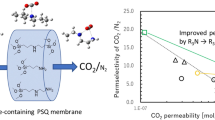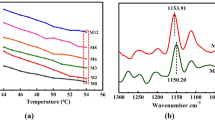Abstract
Bridged polysilsesquioxanes are promising materials for reverse osmosis membranes because they exhibit robust properties. To investigate the effects of the polarity and rigidity of organic components of the polymer on the water permeability of the membrane, two alkoxysilane monomers, 2,5-bis[2-(triethoxysilyl)vinyl]pyridine (BTES-VP) and 1,4-bis[2-(triethoxysilyl)vinyl]benzene (BTES-VB), were synthesized to compare their hydrophilicity and water desalination properties. Water contact angle experiments on the film surfaces revealed that the BTES-VP-derived film was more hydrophilic than the BTES-VB-derived film. Density functional theory calculations of the monomer structures also suggested that BTES-VP is more polar and has a larger dipole moment than BTES-VB. Both membranes prepared from BTES-VP and BTES-VB rejected 95–97% of aqueous sodium chloride and displayed water permeances of 1.1 × 10−13 and 8.5 × 10−14 m3/(m2 Pa s), respectively.
This is a preview of subscription content, access via your institution
Access options
Subscribe to this journal
Receive 12 print issues and online access
$259.00 per year
only $21.58 per issue
Buy this article
- Purchase on Springer Link
- Instant access to full article PDF
Prices may be subject to local taxes which are calculated during checkout











Similar content being viewed by others
References
Misdan N, Lau WJ, Ismail AF. Seawater reverse osmosis (SWRO) desalination by a thin-film composite membrane—current development, challenges and future prospects. Desalination. 2012;287:228–37.
Li D, Wang H. Recent developments in reverse osmosis desalination membranes. J Mater Chem. 2010;20:4551–66.
Shintani T, Matsuyama H, Kurata N. Development of a chlorineresistant polyamide reverse osmosis membrane. Desalination. 2007;207:340–8.
Daer S, Kharraz J, Giwa A, Hasan SW. Recent applications of nanomaterials in water desalination: a critical review and future opportunities. Desalination. 2015;367:37–48.
Mayyahi AA. Important approaches to enhance reverse osmosis (RO) thin film composite (TFC) membranes performance. Membranes. 2018;8:68. https://doi.org/10.3390/membranes8030068.
Xue SM, Ji CH, Xu ZL, Tang YJ, Li RH. Chlorine resistant TFN nanofiltration membrane incorporated with octadecylamine-grafted GO and fluorine-containing monomer. J Membr Sci. 2018;545:185–95.
Aljundi IH. Desalination characteristics of TFN-RO membrane incorporated with ZIF-8 nanoparticles. Desalination. 2017;420:12–20.
Xu R, Wang J, Kanezashi M, Yoshioka T, Tsuru T. Development of robust organosilica membranes for reverse osmosis. Langmuir. 2011;27:13996–9.
Yamamoto K, Ohshita J. Bridged polysilsesquioxane membranes for water desalination. Polym J. 2019;51:1103–16.
Xu R, Kanezashi M, Yoshioka T, Okuda T, Ohshita J, Tsuru T. Tailoring the Affinity of organosilica membranes by introducing polarizable ethenylene bridges and aqueous ozone modification. ACS Appl Mater Interfaces. 2013;5:6147–54.
Xu R, Ibrahim SM, Kanezashi M, Yoshioka T, Ito K, Ohshita J, et al. New Insights into the microstructure-separation properties of organosilica membranes with ethane, ethylene, and acetylene bridges. ACS Appl Mater Interfaces. 2014;6:9357–64.
Zhao L, Ho WSW. Novel reverse osmosis membranes incorporated with a hydrophilic additive for seawater desalination. J Membr Sci. 2014;455:44–54.
Waki M, Mizoshita N, Ohsuna T, Tani T, Inagaki S. Crystal-like periodic mesoporous organosilica bearing pyridine units within the framework. Chem Commun. 2010;46:8163–5.
Li Y, Li S, Zhang K. Influence of hydrophilic carbon dots on polyamide thin film nanocomposite reverse osmosis membranes. J Membr Sci. 2017;537:42–53.
Ohshita J, Muragishi H, Yamamoto K, Mizumo T, Kanezashi M, Tsuru T. Preparation and separation properties of porous norbornane-bridged silica membrane. J Sol Gel Sci Technol. 2015;73:365–70.
Mizumo T, Muragishi H, Yamamoto K, Ohshita J, Kanezashi M, Tsuru T. Preparation and separation properties of oxalylurea-bridged silica membranes. Appl Organomet Chem. 2015;29:433–8.
Yamamoto K, Koge S, Sasahara K, Mizumo T, Kaneko Y, Kanezashi M, et al. Preparation of bridged polysilsesquioxane membranes from bis [3-(triethoxysilyl) propyl] amine for water desalination. Bull Chem Soc Jpn. 2017;90:1035–40.
Yamamoto K, Muragishi H, Mizumo T, Gunji T, Kanezashi M, Tsuru T, et al. Diethylenedioxane-bridged microporous organosilica membrane for gas and water separation. Sep Purif Technol. 2018;207:370–6.
Yamamoto K, Kanezashi M, Tsuru T, Ohshita J. Preparation of bridged polysilsesquioxane-based membranes containing 1, 2, 3-triazole moieties for water desalination. Polym J. 2017;49:401–6.
Liu Y, Tan J, Choi W, Hsu JH, Han DS, Han A, et al. Influence of nanoparticle inclusions on the performance of reverse osmosis membranes. Environ Sci Water Res. 2018;4:411–20.
Frisch MJ, Trucks GW, Schlegel HB, Scuseria GE, Robb MA, Cheeseman JR, et al. Gaussian 09, revision A.02. Wallingford, CT: Gaussian, Inc; 2009.
Guo M, Kanezashi M, Nagasawa H, Yu L, Yamamoto K, Gunji T, et al. Tailoring the microstructure and permeation properties of bridged organosilica membranes via control of the bond angles. J Membr Sci. 2019;84:56–65.
Asay DB, Kim SHJ. Evolution of the adsorbed water layer structure on silicon oxide at room temperature. Phys Chem B. 2005;109:16760–3.
Marsmann HC. Silicon-29 NMR. eMagRes, Wiley 2011. https://doi.org/10.1002/9780470034590.emrstm0505.pub2.
Wang J, Kanezashi M, Yoshioka T, Tsuru T. Effect of calcination temperature on the PV dehydration performance of alcohol aqueous solutions through BTESE-derived silica membranes. J Membr Sci. 2012;415–416:810–5.
Acknowledgements
This work was supported by JSPS KAKENHI Grant Number JP18K14287.
Author information
Authors and Affiliations
Corresponding authors
Ethics declarations
Conflict of interest
The authors declare that they have no conflict of interest.
Additional information
Publisher’s note Springer Nature remains neutral with regard to jurisdictional claims in published maps and institutional affiliations.
Supplementary information
Rights and permissions
About this article
Cite this article
Yamamoto, K., Saito, I., Amaike, Y. et al. Preparation and water desalination properties of bridged polysilsesquioxane membranes with divinylbenzene and divinylpyridine units. Polym J 52, 1367–1374 (2020). https://doi.org/10.1038/s41428-020-0386-x
Received:
Revised:
Accepted:
Published:
Issue Date:
DOI: https://doi.org/10.1038/s41428-020-0386-x
This article is cited by
-
Gel structure and water desalination properties of divinylpyrazine-bridged polysilsesquioxanes
Journal of Sol-Gel Science and Technology (2023)
-
In situ carboxyl functionalization of hybrid organosilica reverse osmosis membranes for water desalination
Advanced Composites and Hybrid Materials (2023)
-
Development of reverse osmosis membranes by incorporating polyhedral oligomeric silsesquioxanes (POSSs)
Polymer Journal (2022)
-
Bridged organosilica membranes incorporating carboxyl-functionalized cage silsesquioxanes for water desalination
Journal of Sol-Gel Science and Technology (2022)



